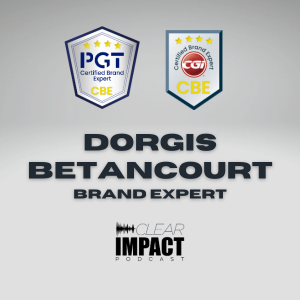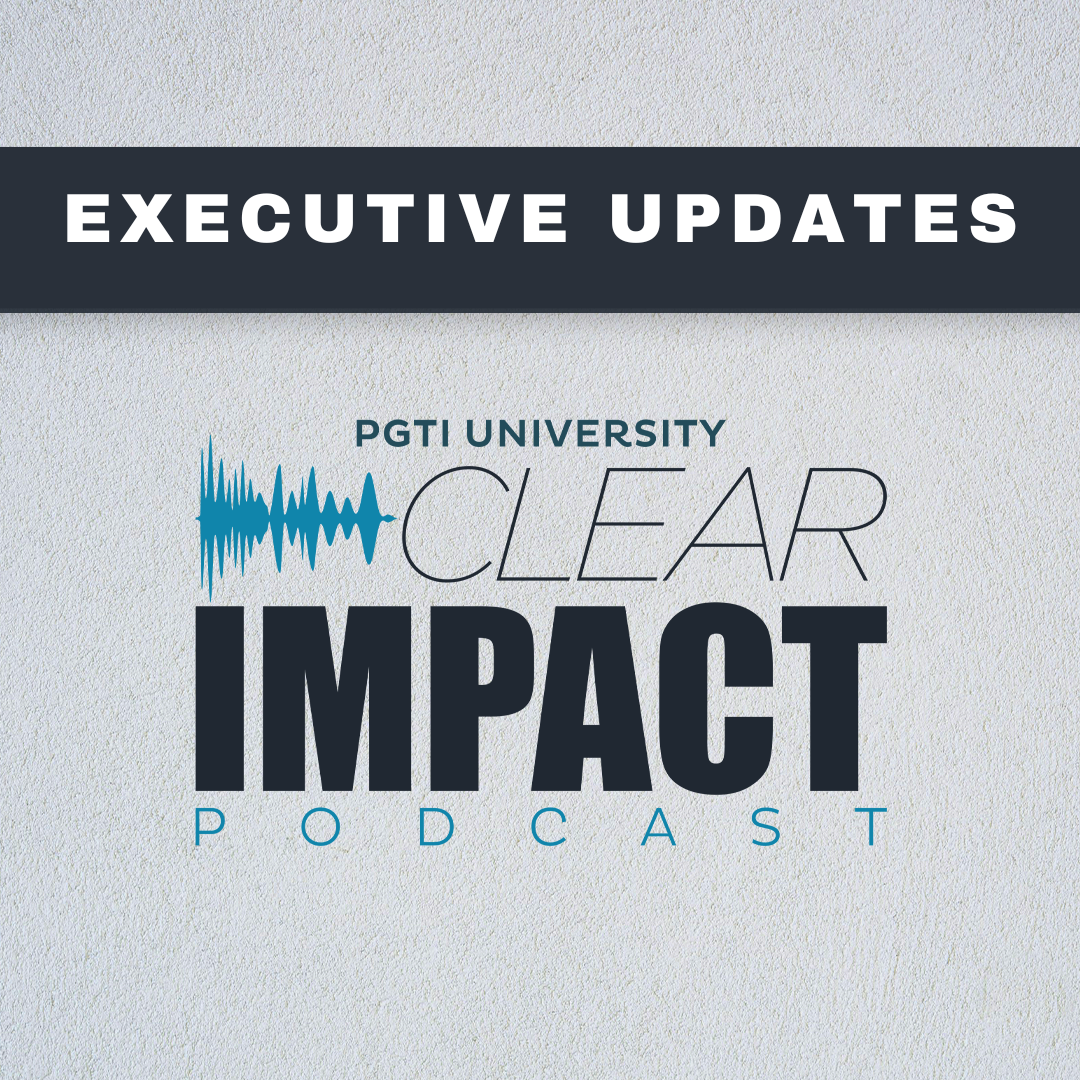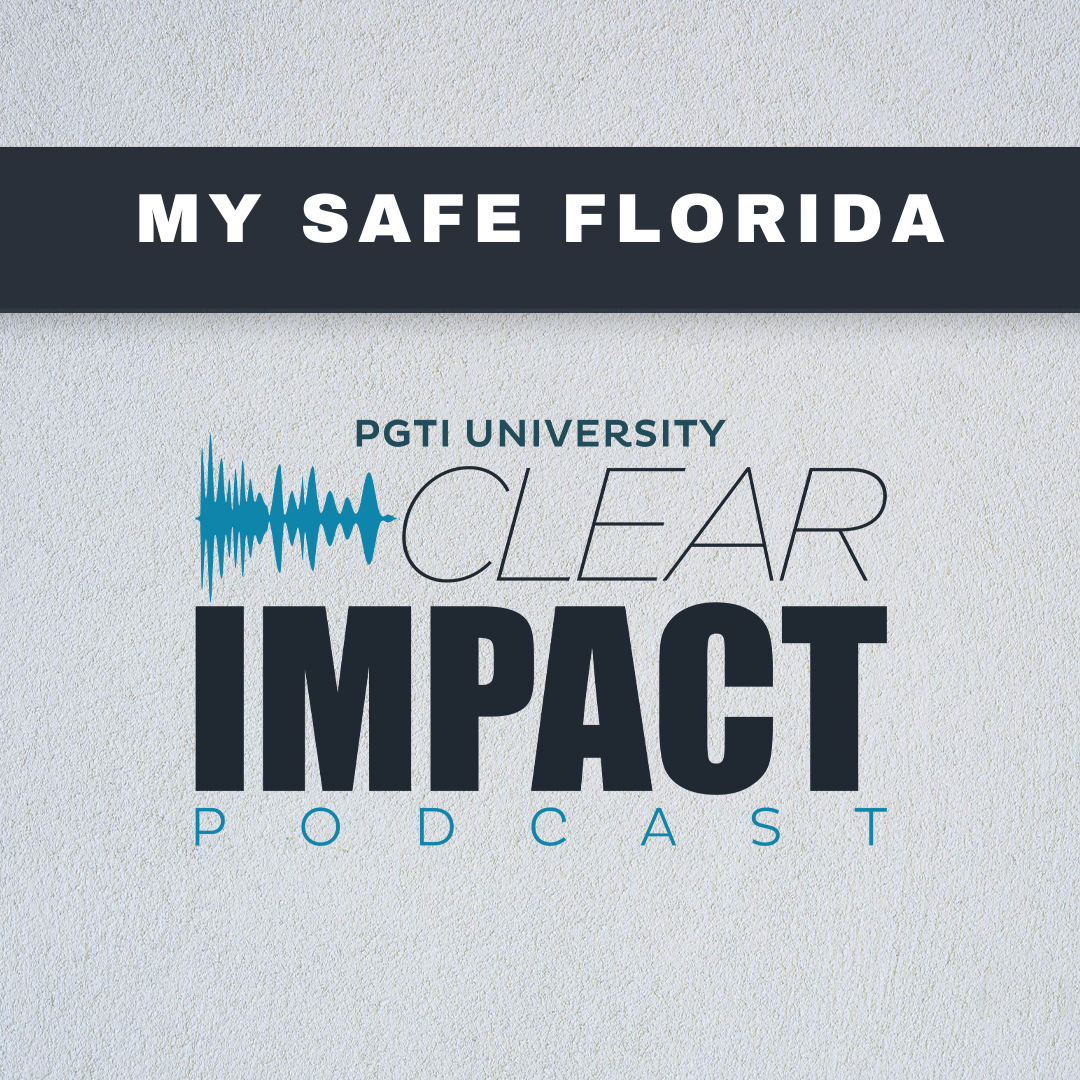Episode Transcript
[00:00:09] Speaker A: Welcome to the Clear Impact Podcast, brought to you by PGTI University. Thanks for joining us today. My name is Sherry Connor and I am your host.
[00:00:24] Speaker B: Good morning. We are here on the Clear Impact Podcast, and we are in a series called windows and doors 301. And today in studio, we have with us Ryan Smith. Welcome to the studio.
[00:00:37] Speaker C: Thank you. Appreciate you inviting me over.
[00:00:39] Speaker B: Yeah, thanks for coming over. And so we're going to be talking about glass cutting today. And, I mean, glass is obviously a huge component of what we do here because we buy these giant sheets, and we've had some conversations already around that. And so my understanding is that you're the guy to talk about glass cutting, and so tell us a little bit about you, and then we'll dive into some questions.
[00:01:03] Speaker C: Awesome. Okay. So obviously, my name is Ryan Smith. I'm from a small town up in Michigan, Munising, where Pictured Rockston is a really beautiful place. If you ever get a chance, go check it out.
[00:01:13] Speaker B: In the summer, though, right?
[00:01:14] Speaker C: Yes, only in the summer. Unless you like to see snow. We have lots of snow in the winter, so.
[00:01:18] Speaker B: No, thank you.
[00:01:19] Speaker C: I hear you there.
[00:01:20] Speaker B: Yeah.
[00:01:20] Speaker C: So I moved here when I was 20 years old to Venice and basically started right at PGT immediately. So I've been working here for the last 19 years. I started out in cutting, so that's kind of why, I guess they lean on me a lot. So I was running cutters back until about 2009, and then I started moving around the company into different leadership roles and quality and engineering.
[00:01:42] Speaker B: Yeah, no, I grew up in Iowa, so I am not a fan of snow. And I moved to Florida when I was in my twenties as well. So we've already recorded an episode with Chris Triana, and he shared a little bit about the glass cutting. But what is the process of how we cut our glass, like the machines and the people and whatever details we want to share because we don't need our competitors stealing any of our stuff. But what would be helpful for our audience to understand about this process?
[00:02:08] Speaker C: I guess from the start of it, we bring in packs of glass, those big Stoss packs we call them, you know, up to, say, 50 sheets per pack. Get them set on our cutters. We have Galactic cutters, but Hegeler, they're beautiful cutters. They've been running great since we got them.
[00:02:22] Speaker B: Is that an XYZ cutter?
[00:02:23] Speaker D: Yep.
[00:02:23] Speaker B: Okay. That's what I've been told it was called, so I just wanted to make sure it wasn't different.
[00:02:27] Speaker C: Nope, nope. Xyz we Used to call it XYZ department back in the day. So. Okay, that's probably where that came from. But yeah. So our production team schedules all the work that, you know, folks order, and we'll put it in the system. And the glass optimization software will tell the crane system where to go pick it from. And it'll pick whatever kind of glass, whatever flavor, whatever thickness anybody orders, batch it all together, and optimize it.
[00:02:51] Speaker B: Okay. And so it's just like a giant jigsaw puzzle, Right. Where this piece can fit here and then this piece can fit here. So it's not necessarily all from a single order or even a single customer. It can just be a variety of different pieces, right?
[00:03:05] Speaker C: Absolutely. Yeah. We'll pull in everything for a given ship date or build date and optimize it all together like you said, jigsaw it all together, and it'll work to get the best yield it possibly can. So it's really good software.
[00:03:18] Speaker B: And so how many people do you have working in that space?
[00:03:20] Speaker C: Usually 15 total between our cutting operation and seaming. Okay, so that's pretty standard.
[00:03:27] Speaker B: Okay. So, Ryan, one of the things that I love is impressing our customers with numbers and, like, how much these massive machines cost. And so do you have any of those numbers?
[00:03:39] Speaker C: So last time we bought these cutters, we bought four total. So we spent over two and a half million dollars on these cutters. In addition, we also brought in the crane system that delivers the glass to the cutters. That was another about $300,000. So we're about $3 million in investing in these cutters.
[00:03:56] Speaker B: And you've got new equipment coming in, so new seamers.
[00:03:59] Speaker D: Yep.
[00:04:00] Speaker C: So those ones, we are spending roughly $2 million total on the seaming portion.
[00:04:05] Speaker B: Wow.
[00:04:06] Speaker C: Yeah, we just. 800,000, almost a million dollars for additional washers to clean the glass after it's been seamed.
[00:04:12] Speaker B: Yeah. We had a customer one time, and I was throwing out. You know, the Joseph machines are this much money and the Emigee machines are this much, and the GED machines are this much, and I love throwing those numbers out. And one of our customers at the end of the tour, he said, I want you to know you crushed my dreams today.
And I was like, what? I'm sorry. Excuse me. And he said, I always dreamed of opening my own manufacturing plant one day. He was like, my pockets are not quite that deep.
[00:04:38] Speaker C: You need some pretty deep pockets. It's very expensive, especially with the technology we have these days. If you want to get anywhere close to the brand new stuff, it's very expensive.
[00:04:48] Speaker B: Well, you have to have the volume to justify it.
[00:04:50] Speaker C: Absolutely.
[00:04:50] Speaker B: And the glass plant certainly does.
[00:04:52] Speaker C: We are busy.
[00:04:53] Speaker B: Yeah, it's 24 7, so that's amazing. Thank you.
[00:04:56] Speaker C: Absolutely.
[00:04:57] Speaker B: And so how many pieces of glass are we cutting a day? I love numbers.
[00:05:01] Speaker C: So it all depends on square footage. So we go by square foot in cutting, Basically, we try to shoot for between 90 and 100,000 a day, depending on volume.
[00:05:11] Speaker B: 100,000 square feet of glass a day?
[00:05:14] Speaker D: Yep.
[00:05:14] Speaker B: Okay. Wow, That's a lot.
[00:05:16] Speaker D: Yep.
[00:05:17] Speaker C: Last year, we consumed right around 30 million square feet.
[00:05:21] Speaker A: We are sharing our expertise around all topics relating to the window indoor industry. Whether you are a customer selling our products or a homeowner doing research, the Clear Impact podcast provides helpful content that makes an impact. Subscribe today wherever you listen to podcasts.
[00:05:39] Speaker B: I can't comprehend that number.
[00:05:41] Speaker C: That's a lot.
[00:05:41] Speaker B: That's a lot. That's a lot. And so it's like I've messed around with stained glass before, and so I know just, like, this much, which is not a very big amount around cutting glass. And so what factors come into play with that? Like, does weather matter? Does the thickness of the glass matter? The texture of the glass matter? Like, what kinds of things do you have to consider?
[00:06:04] Speaker C: Yep, I would say the most important is thickness. So we have three different thicknesses here, and each one require different pressure and different cutting wheel, potentially. So there's a lot that goes into making sure that we're setting the system up correctly, because the cutters themselves will actually take all that information and do what needs to be done based on your glass type. But that's basically, I guess, what's the most important part of it.
[00:06:26] Speaker B: And so for the texture, like, because we have a couple of obscure things, I'm guessing that they flip them over and they cut the backside of that, right?
[00:06:35] Speaker D: Yep. Yep.
[00:06:35] Speaker C: We'll cut, I guess, the flat side of it. It's a lot more brittle than regular glass, so it takes a lot less pressure. So we set that up in the system. Say, normal glass would say, six, seven pounds of pressure. We'll run that, say, five to four pounds of pressure.
[00:06:48] Speaker B: Yeah. So you got to be careful with that. I learned a little bit about that. And so one of the things that I didn't realize for a while is that the cutters can do some curves, like so some arches or eyebrows or whatever. So what is the criteria between hand cutting something versus cutting it on a machine? Because we still do hand cutting as well, right?
[00:07:12] Speaker D: Yep.
[00:07:12] Speaker C: So we have a pretty Extensive shape catalog that whenever anybody orders a shape, we can usually tie it back to that. But there will be times when we do what we call like digitized files or templates. So if some customer out in the field needs to get an exact replacement and it's an odd shape or something weird, we'll send that to hand cut and we'll basically either trace the frame or trace a template and manually cut that out. The other time we use hand cut over, any of the shape cutting software would be if there's inside corners, what we call like a quadrofoil. So we have to manually drill those corners out and then cut around.
[00:07:46] Speaker B: Yeah. Because you can't cut a curve necessarily with glass. Like you have to make little scores on the inside and then break it out.
[00:07:53] Speaker C: Yeah. Anytime you have an inside corner, it's very difficult. Radiuses, stuff like that, not so bad. But the inside corners are what gets you.
[00:08:00] Speaker B: And so do you have like a percentage of how much of our glass is cut by hand versus machine?
[00:08:04] Speaker C: Probably 99% is cut by machine. We have a small hand cutting department. It'll be those custom, very niche type things.
[00:08:11] Speaker B: Yeah. Cause we do talk about that on the tours at AP1. We stand, you know, we talk about the fact that there's a lot of manual labor involved with architectural shapes and that some of that glass is cut by hand. And you know, then that's. If it's an ig, then it's, you know, or laminated. Then it's multiple pieces of glass because you're cutting it in the annealed state. You're not waiting until it's tempered and laminated and then trimming it.
[00:08:35] Speaker A: Right.
[00:08:35] Speaker B: You gotta do it while it's raw and then process it. So there's just a lot of labor involved in those types of units and that's why the cost is higher.
[00:08:43] Speaker C: Yep. Especially one of the things that's the most challenging is non symmetrical shapes. Anything that's symmetrical, like a radius or like a half eyebrow, anything like that. Those are pretty easy. It's the ones that are like the oblong eggs and ovals and stuff like that that are really the challenging ones.
[00:08:58] Speaker B: Yeah, I would imagine there's definitely some skills involved there. And so one of the questions I always like to ask is, how does this benefit our dealers? Like the process that we have in house for cutting all of that? How does this benefit our customer base?
[00:09:12] Speaker C: I would say the most important thing is the price. We can do it quite a bit cheaper since it's done in house, since the Whole process is done in house. Faster turnarounds. We have rushes twice a day.
Anything that's broken and downstream gets back to the cutters. We'll recut it and get it back into the process immediately. And I guess overall flexibility gives us a lot of versatility, lets us be able to do a lot of the oddball type things that our customers request and be able to turn them in a reasonable amount of time.
[00:09:37] Speaker B: That's awesome. I know one of the things that we talk about is, you know, our engineers here are amazing, and everybody wants to say yes, like, no, we can't do it. That is a hard sentence to say. And so even if it is something that's very unusual, we're going to work really hard to say yes to that, provided that it's a standard, safe, and viable option. You know, some angles and things like that we can't do because of the frame limitations and size limitations. But if we can build it and put it in an opening and have it be beautiful and have it work, then we've reached our happy spot that day, right?
[00:10:08] Speaker C: Yeah. We've done a lot of crazy things over the years, and I think when you do those, you feel a lot of accomplishment Once you get them done, you know, it's tough to work through. But once you get it, you know, to the end customer, it's really nice to see.
[00:10:19] Speaker B: Yeah, that's awesome. Is there anything else you'd like to share, Ryan?
[00:10:22] Speaker C: Nothing too crazy. We're going to be launching wet seaming for the cutters coming at the end of the year here. So that's going to have a big impact on our edge quality. So a lot of good things coming that way.
[00:10:32] Speaker B: Are those the auto seamers?
[00:10:33] Speaker D: Yep.
[00:10:34] Speaker C: We're getting two auto seamers and two manual wet seamers. But the wet seaming is a little bit better for your edge quality. So overall, throughout the plant, we're going to have better edge quality coming out of the glass ops.
[00:10:44] Speaker B: Nice. And what will that do as a result?
[00:10:47] Speaker C: It's going to be a little less breakage. Sometimes we see stuff in the field, like thermal brakes or stuff like that. We were expecting to see those drops and some of the issues we do have in assembly plant installing the glass. I think we'll see less breakage there, too.
[00:10:59] Speaker B: Yeah. It's so funny. I was touring somebody I don't know. This was a couple of weeks ago, and there was a piece of broken glass, like, setting aside, and they were like, is that broken? And I was like, well, yeah, we work with glass all the time. Like, it's fragile. Like it's going to break. Like, obviously we don't want it to break. But yeah, this is just part of the hazard of working with a breakable product, right?
[00:11:21] Speaker C: Yeah.
[00:11:22] Speaker B: Like, yeah, it breaks. So, anyway, well, this has been a fun conversation. Happy Friday to us. Thanks for making time for me today. Ryan, I appreciate you coming in and having this conversation.
[00:11:31] Speaker C: This is a blast. Thank you for inviting me.
[00:11:32] Speaker B: All right, thanks. Bye.
[00:11:35] Speaker A: The Clear Impact podcast is brought to you by PGTI University. We are a part of Mitre Brands, a family of leading window and door brands united by our passion for quality and relentless pursuit of 100%. One of the missions of Mitre Brands is to unite and deliver the finest customer experience possible across the nation. Our window and door brands deliver regionalized expertise, expertise and products. Backed by a national company, PGTI University is here to educate you, our listener, so that you can be a more informed consumer of window indoor products.


